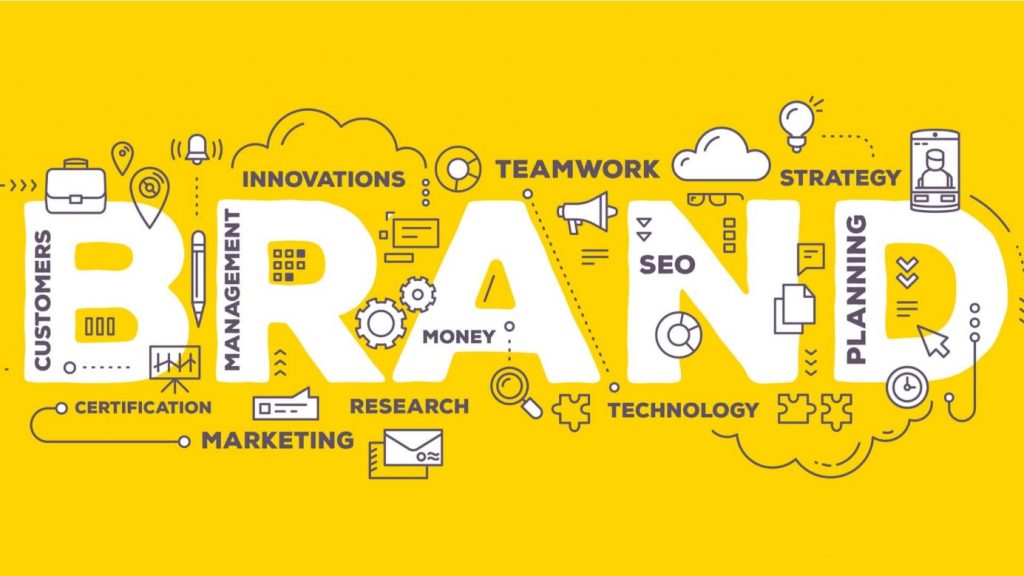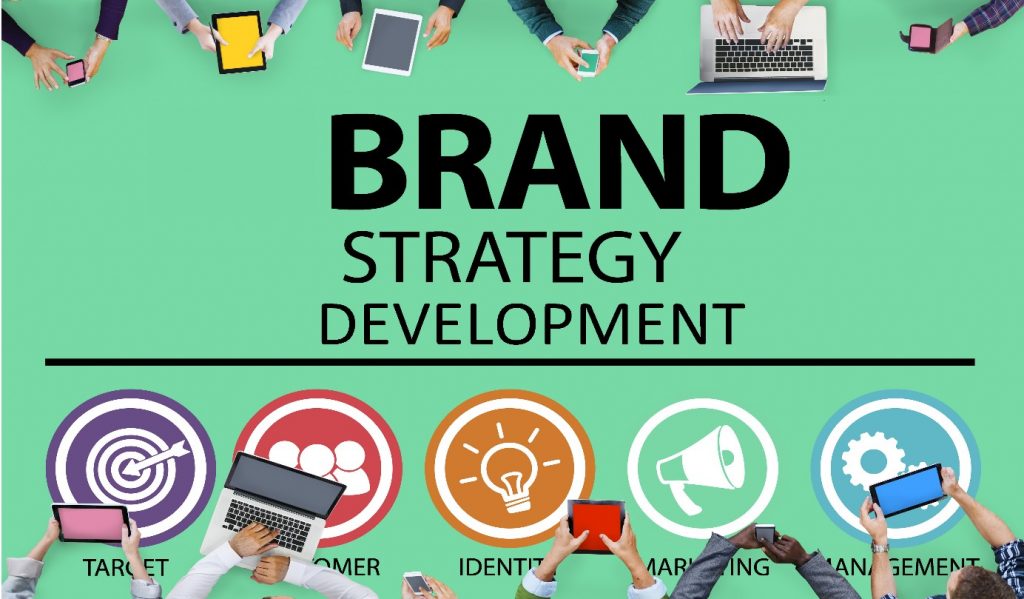Developing a Successful Brand Strategy: How it can Benefit Your Company
Branding strategy
A successful brand strategy is a long-term plan designed to achieve specific goals that lead to customers recognizing and preferring your brand. This involves defining your brand’s objectives, promises to customers, and how they are communicated to the market.

While creative elements like logos, colour palettes, and websites are important, they are just one piece of the puzzle. Brand strategy development encompasses all the intangible factors that promote brand recognition, equity, and sentiment over time. By developing a strong and effective brand strategy, you can set your company up for success in the long run.
Definition of Brand Development
The process of developing and enhancing your professional services brand is known as brand development. We split the process into three parts when assisting businesses with brand development.
- The first step is to ensure that your brand strategy is correct and connected with your business goals
- The second step is to create all of the tools you’ll need to express your brand, including a logo, slogan, and website
- Finally, you’ll need to reinforce your freshly created or revised brand
Wherever you are and whatever your business is about, you can always rely on our experts at Absolutecreative for brand strategy development.
10 Steps to Developing a Successful Brand Strategy: A Comprehensive Tutorial”
Your approach to accomplishing these tasks is shaped by your brand development strategy. To simplify matters, we’ve segmented the brand development process into ten distinct phases.
“Consider Your Overall Business Strategy”
Having a strong and unique brand can significantly facilitate the growth of your business. However, it’s important to determine the type of business you’re seeking and whether you plan to expand organically. To begin developing your brand strategy, start with your overall business strategy as it sets the context for your brand. By defining your business goals clearly, your brand can serve as a powerful tool to help you achieve them and lead your company in the right direction.
“Understanding Your Target Audience”
If someone asks you who your ideal customers are, answering “everyone” would be a significant mistake. Our research shows that successful companies with high growth and profits have a clear focus on their target clientele. The more rapid the growth, the more precise the focus should be. As your target audience becomes more diverse, your marketing efforts will become less effective. To ensure that you have selected the right customer segment, the next step in developing your brand strategy is crucial.
“Understanding Your Clients’ Needs”
Businesses that conduct thorough research on their target audience tend to grow and profit more quickly. Moreover, companies that conduct research on a regular basis, at least once every quarter, experience even faster development.

Conducting the research helps you gain a deeper understanding of your target audience’s perspective and goals, anticipate their needs, and communicate your message in a way that resonates with them. Additionally, research reveals how your company’s capabilities and brand are perceived by the public. Consequently, conducting research significantly reduces the marketing risks associated with brand strategy development.
“Enhancing Your Brand Positioning”
It’s time to determine your company’s position in the professional services industry, also known as market positioning. What distinguishes your company from your competitors and why should potential clients in your target market select your services?
The foundation of your brand positioning is reflected in a positioning statement, typically consisting of three to five words. It should be grounded in reality, as you will be held accountable for delivering on your commitments. Additionally, it should be aspirational, providing a goal to strive for.
“Developing Your Messaging Strategy”
After developing a brand positioning strategy, the next step is to create a messaging plan that effectively communicates this positioning to different target audiences. These audiences may include potential clients, employees, referral sources, influencers, and partnership possibilities.
While your brand positioning should remain consistent across all audiences, it’s important to highlight different elements that will resonate with each group. Each audience will have unique concerns and issues that need to be addressed, and they will require different forms of proof to back up your claims.
By tailoring your messaging strategy to address the unique needs and concerns of each audience, you can ensure that your brand strategy is relevant and effective in reaching your target market. This is a crucial step in creating a strong and lasting brand identity that resonates with customers and establishes a strong presence in the marketplace.
“Building Your Brand Identity: Name, Logo, and Tagline”
In many cases, businesses do not require a name change. However, if you are a new company, going through a merger, or have a name that no longer aligns with your brand positioning, a name change might be necessary.
Even if you decide not to change your company name, updating your logo and slogan to better align with your brand strategy could be advantageous. It’s important to remember that your name, logo, and slogan are not your brand; they are simply components of your brand identity, or the way your brand is represented or symbolized. To truly bring your brand to life, you must live it.

Furthermore, avoid the error of solely circulating the new logo internally for approval. Remember that you are not the target audience for the name, logo, or tagline. These elements should be evaluated based on how effectively they communicate to the marketplace, rather than how much the partners like them.
“Creating Your Content Marketing Strategy”
While this phase is commonly referred to as “creating your marketing plan,” we take a different approach and recommend implementing a content marketing strategy instead. Why? In today’s digital age, content marketing is particularly well-suited for professional service businesses as it effectively fulfills all the functions of traditional marketing.
By providing relevant educational content, it attracts, nurtures, and qualifies potential customers. Remember that the strength of your brand is determined by both its reputation and exposure. It’s rare to increase awareness without also improving your reputation, which is why traditional methods like advertising and sponsorships aimed at increasing awareness are often ineffective.
On the other hand, content marketing can improve both exposure and reputation simultaneously. It’s also an excellent way to make your brand more relevant to your target audience.
“Building Your Company’s Website: A Step-by-Step Guide”
Your website is the most important tool for establishing your brand. It’s where your entire audience goes to discover what you do, how you do it, and who your customers are. While clients are unlikely to choose your company based solely on your website, a website that conveys the wrong message could disqualify you from consideration.
Furthermore, your website will house crucial content that will be the focal point of your search engine optimization (SEO) efforts. This will enable potential customers, employees, and referral sources to discover and learn more about your company. Therefore, any brand strategy development should include a focus on your online content.

Modern professional services websites can be classified into two categories. The first is a branding website, which tells your story and conveys your brand’s message by showcasing who you are, who you serve, and what you do. The second type achieves all of the above whiles also generating and nurturing potential new customers. These are known as High-Performance Websites.
“Crafting Your Marketing Toolkit: Essentials for Success”
The subsequent step is to finalize the remaining components of your marketing toolkit. This may include one-page “sales sheets” outlining your main service offerings or the markets you serve. A brief “pitch deck” providing an overview of your business or primary offerings, as well as an e-brochure about your firm, may also be included. Printed materials are no longer as common, and video content is increasingly being included in the marketing toolkit.
Popular video themes include firm overviews, case studies, and “meet the partner” videos, as well as highlighting key service offerings. These tools can aid not only in business development but also in brand strategy development if they are designed properly.
“Executing, Monitoring, and Adapting Your Strategy for Success”
The final phase of brand strategy development is arguably the most critical. After all, a well-crafted plan is of little value if it is never put into action. It may surprise you to know that this happens all too often. Despite good intentions, a robust strategy is created and put into practice, only to fall by the wayside as reality sets in. Employees become consumed with client work, and brand development efforts are postponed, eventually fading from memory altogether.

That’s why monitoring is essential. At Absolutecreative, we strongly recommend keeping track of both the performance of the plan and the outcomes. Is the strategy being executed as intended? What happened to key metrics such as search traffic and website visits? How many new leads, job applications, and partnership opportunities were generated? By following the entire process, you can be certain that you are drawing the correct conclusions and making the appropriate adjustments.
How can you ensure the success of your brand strategy development?
The fundamental aim of a good branding strategy is to effectively communicate to the world that your brand exists, what it stands for, and what sets it apart from competitors. Developing a brand strategy is a fluid, long-term plan that should be regularly reviewed based on its performance over time. However, assessing the success of branding initiatives can be challenging due to intangible, difficult-to-quantify aspects, making it critical to establish how success will be measured from the start.
While every business will take a different approach to measure success, all effective brand strategies will include the following aspects:
- What are the goals of your brand, and how will they be communicated? This involves identifying the key issues that your brand will address and how they will help your target audience.
- How do you determine who your ideal clients are and how to reach them? This involves understanding the needs, desires, and pain points of your target audience and how your brand can address them.
- How do you identify your competitors and how they are addressing your potential customers’ needs? This involves researching your competitors and understanding how they are positioning themselves in the marketplace.
- What methods will you use to engage potential customers, and what personality and tone of voice will your brand need to fulfill its objectives? This involves developing a strong and consistent brand personality and messaging that resonates with your target audience.
By answering these questions and developing a comprehensive brand strategy that addresses each aspect, you can establish a strong and effective brand identity that sets your business apart from competitors and resonates with customers.
“Unlocking the Secret to Winning More Clients: The Importance of Developing a Strong Brand Strategy”
Brand management can be compared to managing an investment portfolio. By making sound initial decisions, you can sit back and watch your choices yield significant returns over time. However, occasional troubleshooting may be necessary if you encounter any operational issues.

If you feel like something crucial is missing, it may be worthwhile to re-evaluate certain elements of your brand, such as the font or colour scheme. Failure to present ideas effectively can result in them being overlooked, underscoring the importance of making wise decisions about your brand’s objectives, vision, values, voice and tone, and visual identity to stand out from the competition.
By examining your existing brand strategy and allowing it to work for you, you can intervene only when necessary, ensuring that your brand propels your company’s growth and success. The ups and downs of rebranding demonstrate the significance of long-term brand maintenance and the need for a robust brand strategy from the outset to achieve sustained success.
Absolute Creative the key to success.
Looking to take your business to the next level? Look no further than Absolute Creative Our expert team can help you develop and implement a comprehensive brand strategy, digital brand strategy, marketing plan, business plan, and advertising campaign to achieve your goals.
We don’t just stop at strategy development – we’re committed to ensuring your success by continually monitoring and refining all aspects of your operations to maximize your ROI.
Our unique branding strategy, established by Brandon Karimi in 2009, ( 6 brand essentials) incorporates six fundamental brand elements that address all aspects of your business. With our research and analysis, we develop brands and positions in the market that emotionally connect with your target audience and leave a lasting impression.
But that’s not all – we also prioritize creating an inspiring and rewarding environment for our employees, ensuring that our team is always motivated to deliver the best possible results for our clients. Whether you’re based in Canada or abroad, we’re excited to help you achieve your business objectives.
